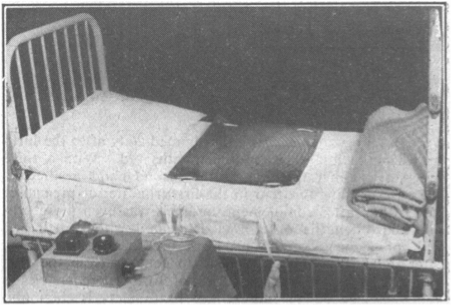Dr Claire Jones, Senior Lecturer in the History of Medicine, has been awarded a prestigious Arts and Humanities Research Council (AHRC) fellowship for her new project on ‘Buzzers for Bedwetters: Incontinence and the Urinary Body in Britain, 1870–1970’. Congratulations Dr Jones! We’re very excited to follow her progress. Here, Dr Jones explains what the project is all about:
 A nocturnal enuresis alarm placed on a child’s bed. From T.H. Gillison and J.L. Skinner, ‘Treatment of Nocturnal Enuresis by the Electric Alarm,’ British Medical Journal, (22 November 1958), p. 1268.
A nocturnal enuresis alarm placed on a child’s bed. From T.H. Gillison and J.L. Skinner, ‘Treatment of Nocturnal Enuresis by the Electric Alarm,’ British Medical Journal, (22 November 1958), p. 1268.
During the summer of 2023, I was lucky enough to receive an AHRC Research, Development and Engagement Fellowship in the last round of this award scheme. Running between June 2024 and January 2026, the project will examine the ways in which the incontinent body and urine ‘as matter out of place’ was transformed into a significant moral problem in Britain during the hundred years between 1870 and 1970.
During this period, the rise of the public health movement signalled the state’s desire to control the nation’s water supply, but the simultaneous medicalisation, commercialisation and stigmatisation of incontinence demonstrated the desire for greater control of the flow of urine from the individual body. Incontinence was deemed polluting to the body politic, but fixable by new surgical, pharmaceutical, psychological and technological interventions. When not fixable, incontinent bodies were deemed burdensome by the sufferers themselves, their families, the medical profession and the state and given as a major cause of hospital bed-blocking and mental health problems.
To highlight incontinence as a key moral issue in this period, the research focuses on the discursive and experiential aspects of four key incontinent bodies: the child; the reproductive (including post-partum women and masturbating men); the war veteran; and the elderly. It will demonstrate how late nineteenth-century medical practitioners interested in the male reproductive body began to compare urine incontinence to the stigmatising sexual condition of spermatorrhoea and sexual infections such as gonorrhoea, thus demonstrating the significance of incontinence to the growing specialism of sexual science. Simultaneously, practitioners in the new specialism of gynaecology were claiming cures for the long-running issue of post-partum urinary incontinence through new operations treating vescio-vaginal fistulae, while women’s welfare organisations were fighting for maternity services to tackle debilitating incontinence among working class mothers.
During the First World War, enuresis (bed wetting) formed an important part of a British soldier’s medical record and the condition, either newly acquired by psychological or physical trauma or from childhood, formed an integral part of the stated reason for their dismissal from service. Into the interwar period, the rise of child social work and psychoanalysis provided new arenas for the problematisation of nocturnal enuresis and medical attention turned towards the child. The evacuation of child bedwetters provoked panic during the Second World War, whereafter numerous physical and psychological cures were developed. While the incontinent child remained a focus into the post-war period through habit training cures (via electric buzzers) and antidepressants, new medical emphasis was also placed on the elderly through the rise of the medical specialism of gerontology, the establishment of the NHS and shifts from institutional to community care, which became increasingly privatised from the 1970s. In these contexts, incontinence was considered incurable and those suffering from the condition as bed-blockers.
By highlighting the leaky bodily fluid of urine as a perceived disrupter of social order, this project emerges at an important juncture in body history and the social history of medicine. It draws on approaches from sociology and anthropology to provide a new case study of bodies uncontrolled and unbounded. Through its partnership with Britain’s two main incontinence charities – Bladder and Bowel UK and ERIC, The Children’s Bowel & Bladder Charity – the project will also provide important historical insights into contemporary incontinent bodies of which there are many in Britain, as elsewhere. Recent estimates suggest that around 14 million people in Britain suffer from incontinence, including as many as 1 in 12 children and 25-45% of women who suffer from stress urinary incontinence and pelvic organ prolapse. The project will not only demonstrate how contemporary taboos toward incontinence have been historically shaped, but aims to break down these taboos, giving those with incontinence and their families a chance to lead easier and less stigmatised lives.
There will also be a one-year post-doctoral position on the project advertised for a January 2025 start, so watch this space or get in touch with any questions! Contact Dr Claire Jones at c.l.jones-26@kent.ac.uk.
